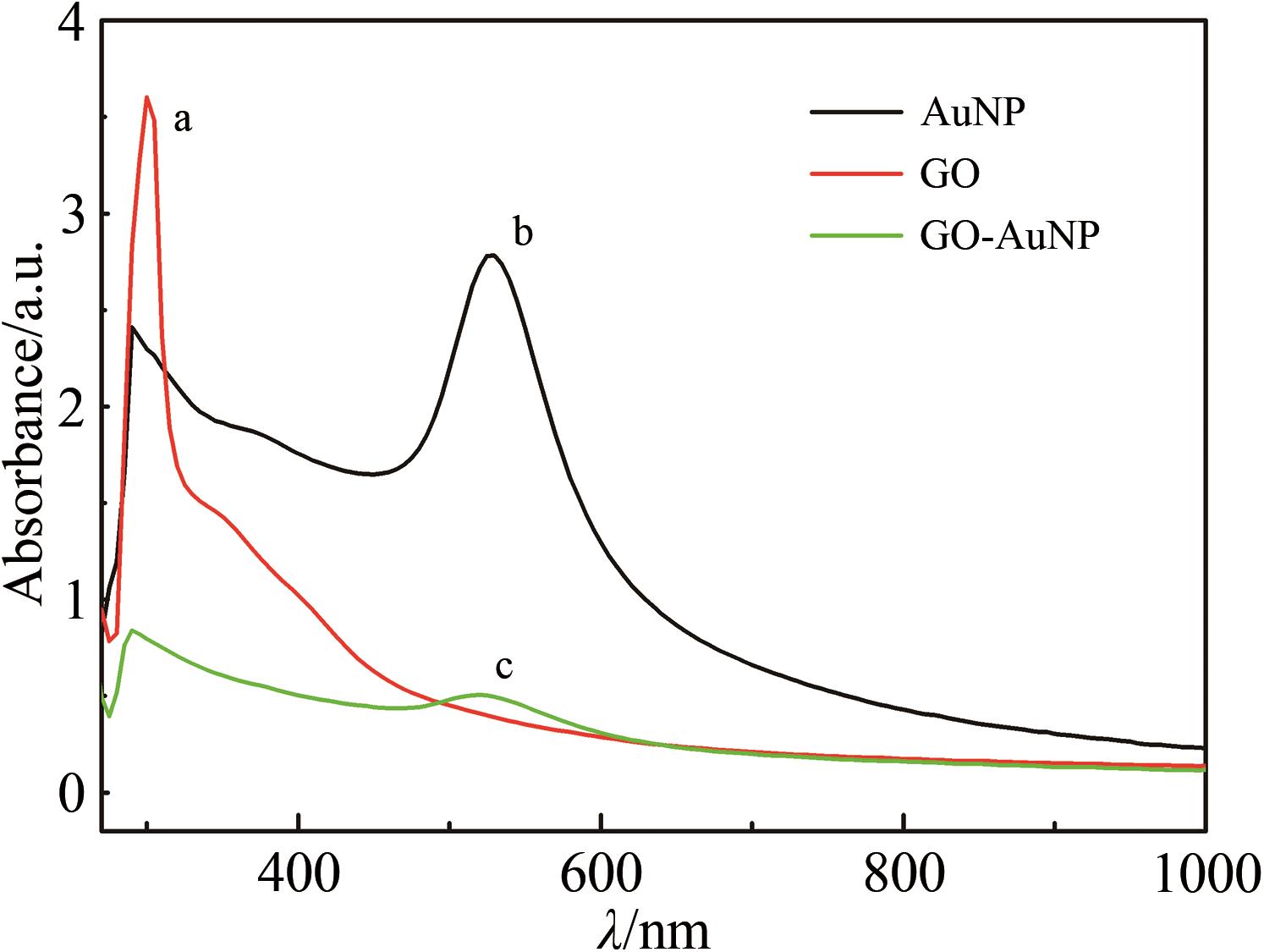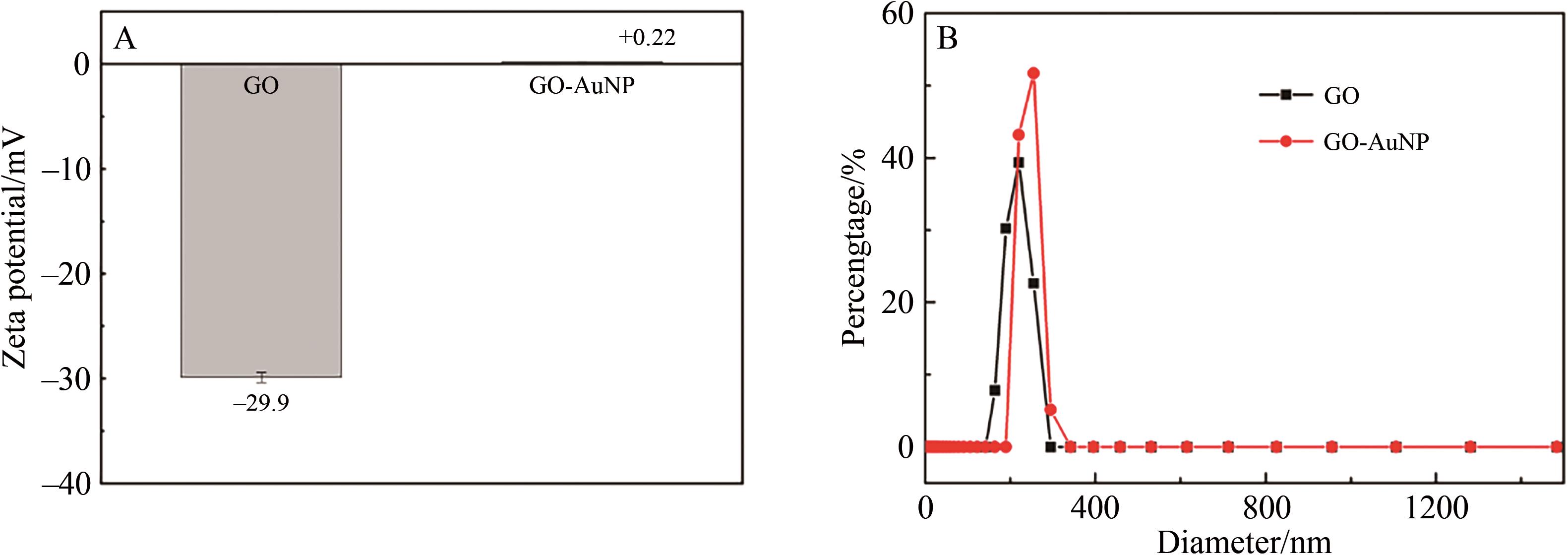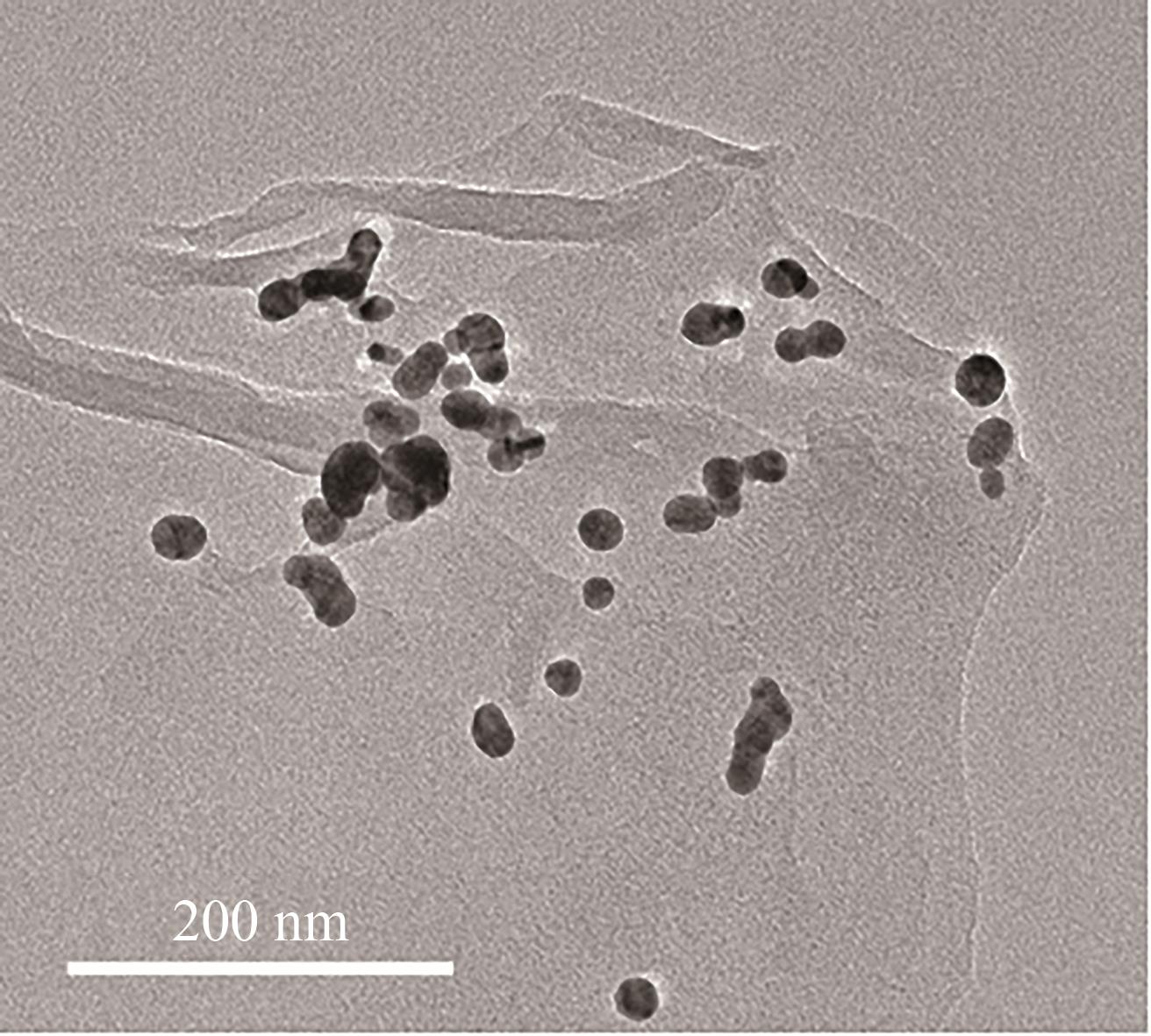
应用化学 ›› 2024, Vol. 41 ›› Issue (7): 976-986.DOI: 10.19894/j.issn.1000-0518.230402
金纳米球-氧化石墨烯纳米药物载体的制备及抗癌性能
郭国英1, 赵墨晅1, 梁文婷2, 弓韬1,2( ), 董川2(
), 董川2( )
)
- 1.山西医科大学生物化学与分子生物学教研室,太原 030001
2.山西大学环境科学研究所,太原 030006
-
收稿日期:2023-12-28接受日期:2024-04-03出版日期:2024-07-01发布日期:2024-08-03 -
通讯作者:弓韬,董川 -
基金资助:国家自然科学基金(21976113);山西省自然科学基金(202103021224240)
Preparation and Anti‑Cancer Properties of Gold Nanosphere‑Graphene Oxide Nanodrug Carriers
Guo-Ying GUO1, Mo-Xuan ZHAO1, Wen-Ting LIANG2, Tao GONG1,2( ), Chuan DONG2(
), Chuan DONG2( )
)
- 1.Department of Biochemistry and Molecular Biology,Shanxi Medical University,Taiyuan 030001,China
2.Institute of Environmental Science,Shanxi University,Taiyuan 030006,China
-
Received:2023-12-28Accepted:2024-04-03Published:2024-07-01Online:2024-08-03 -
Contact:Tao GONG,Chuan DONG -
About author:dc@sxu.edu.cn
gyt830626@163.com
-
Supported by:the National Natural Science Foundation of China(21976113);the Natural Science Foundation of Shanxi Province(202103021224240)
摘要:
采用化学还原法制备了氧化石墨烯-金纳米球(GO-AuNP),利用透射电子显微镜(TEM)、紫外-分光光度计(UV-Vis)和激光粒度仪等对GO-AuNP进行了表征,并利用红外热成像仪对其光热性能进行了研究。 将GO-AuNP负载抗癌药物盐酸阿霉素(DOX)制备成纳米药物复合物(GO-AuNP@DOX),并通过荧光分光光度计对DOX的负载和释放进行了检测; 结果显示,GO-AuNP@DOX中DOX的释放在弱酸性环境下更优,并且在808 nm激光照射条件下pH=5.3时释放量可以达到30.51%。 采用共聚焦显微镜分析了癌细胞对GO-AuNP@DOX的摄取能力; 采用CCK-8细胞毒性实验分析了GO-AuNP@DOX的体外杀伤肿瘤细胞能力,细胞毒性实验证明GO-AuNP载体具备良好的生物相容性,体内抗肿瘤实验结果表明,荷瘤小鼠在化疗-光热协同作用可以很好地抑制肿瘤生长。 结果表明,GO-AuNP纳米药物载体具有光热转换能力优异、生物相容性优良的优点,其pH/近红外光谱(NIR)双重药物控释性能使药物载体在化疗-光热协同治疗肿瘤方面具有潜在的应用价值。
中图分类号:
引用本文
郭国英, 赵墨晅, 梁文婷, 弓韬, 董川. 金纳米球-氧化石墨烯纳米药物载体的制备及抗癌性能[J]. 应用化学, 2024, 41(7): 976-986.
Guo-Ying GUO, Mo-Xuan ZHAO, Wen-Ting LIANG, Tao GONG, Chuan DONG. Preparation and Anti‑Cancer Properties of Gold Nanosphere‑Graphene Oxide Nanodrug Carriers[J]. Chinese Journal of Applied Chemistry, 2024, 41(7): 976-986.
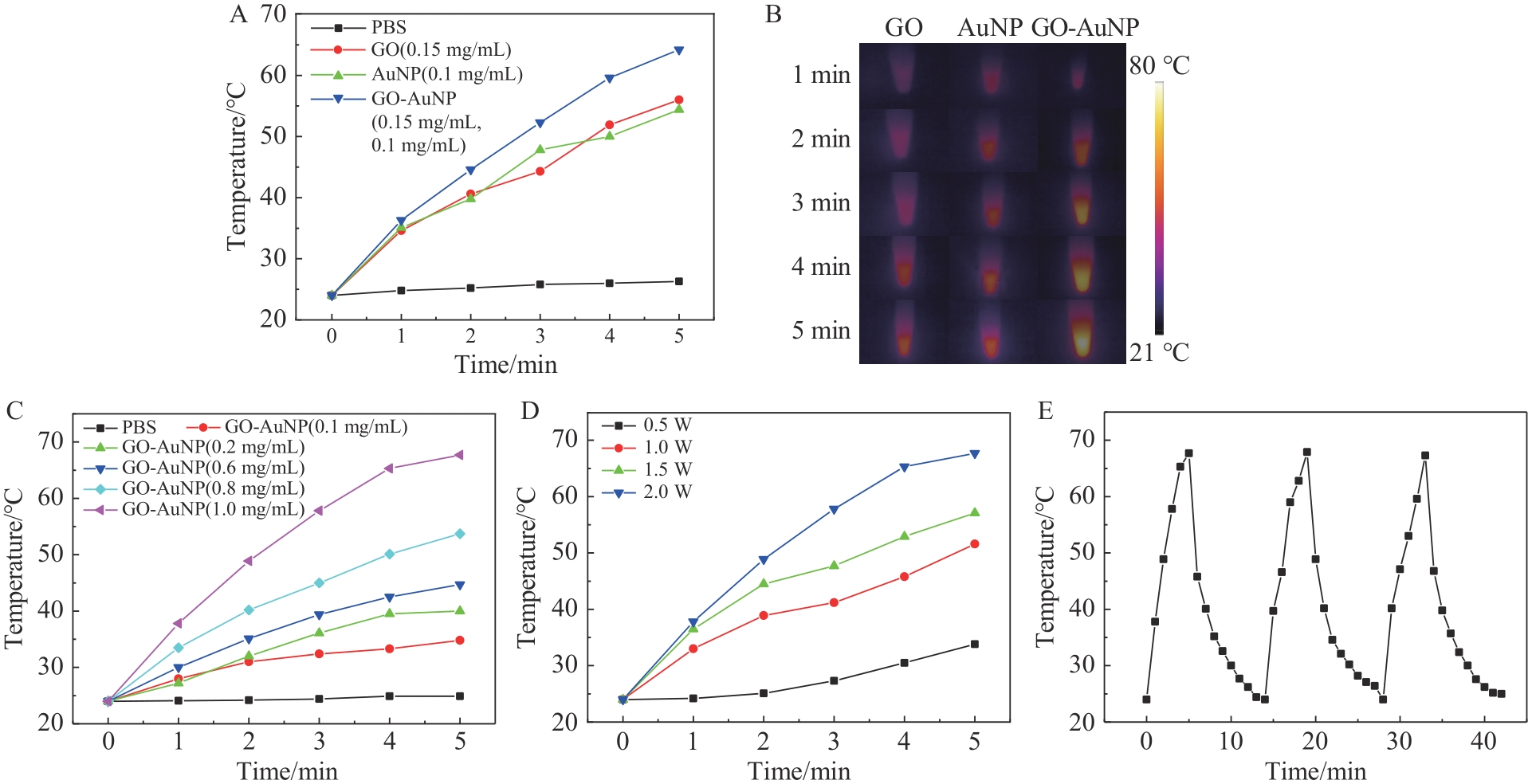
图5 GO-AuNP不同组分在NIR照射下(2.0 W/cm2)的温度变化曲线(A)和相应的红外热图像(B); 不同质量浓度GO-AuNP在NIR照射(2.0 W/cm2)下的温度变化图(C); GO-AuNP在不同功率NIR照射下的温度变化图(D); GO-AuNP温度周期变化图(E)
Fig. 5 Temperature change curves (A) and corresponding infrared thermal images (B) of different components of GO-AuNP under NIR irradiation(2.0 W/cm2); Temperature variation graph of GO-AuNP at different concentrations under NIR irradiation(2.0 W/cm2) (C); Temperature variation graph of GO-AuNP under different power NIR irradiation (D); Temperature cycle variation graph of GO-AuNP (E)

图6 (A) GO-AuNP对DOX的载药动力学曲线; Lagergren's伪一级(B)和Ho's 伪二级(C)动力学模型的线性拟合图
Fig.6 (A) The adsorption kinetic curves of GO-AuNP on DOX; Linear fitting graphs of the dynamic model for Lagergren's pseudo-first-order (B) and Ho's pseudo-second-order (C)
| Lagergern's pseudo?first?order kinetic model | Ho's pseudo?second?order kinetic model | ||||
|---|---|---|---|---|---|
| qe/(mg·g-1) | K1/h-1 | R2 | qe/(mg·g-1) | K2/(g·mg-1·min-1) | R2 |
| 24.64 | 0.027 75 | 0.987 6 | 41.07 | 0.001 700 | 0.999 7 |
表1 GO?AuNP对DOX的载药动力学相关参数
Table 1 Parameters related to the drug delivery kinetics of GO?AuNP to DOX
| Lagergern's pseudo?first?order kinetic model | Ho's pseudo?second?order kinetic model | ||||
|---|---|---|---|---|---|
| qe/(mg·g-1) | K1/h-1 | R2 | qe/(mg·g-1) | K2/(g·mg-1·min-1) | R2 |
| 24.64 | 0.027 75 | 0.987 6 | 41.07 | 0.001 700 | 0.999 7 |

图7 (A) GO-AuNP对DOX的等温吸附图; Langmuir单分子层(B)和Freundlich多分子层(C)吸附模型的线性拟合图
Fig.7 The isothermal adsorption curve of GO-AuNP on DOX (A); Linear fitting graphs with the Langmuir adsorption isotherm model (B) and Freundlich adsorption isotherm model (C)
| Langmuir isotherm model | Freundlich isotherm model | ||||
|---|---|---|---|---|---|
| qm/(mg·g-1) | KL/(mg·mL-1) | R2 | n | Kf /(mL·g-1) | R2 |
| 458.8 | 0.042 80 | 0.887 0 | 515.5 | 1.011 | 0.995 1 |
表2 GO?AuNP对DOX的等温吸附相关参数
Table 2 Parameters related to the drug isothermal adsorption of GO?AuNP to DOX
| Langmuir isotherm model | Freundlich isotherm model | ||||
|---|---|---|---|---|---|
| qm/(mg·g-1) | KL/(mg·mL-1) | R2 | n | Kf /(mL·g-1) | R2 |
| 458.8 | 0.042 80 | 0.887 0 | 515.5 | 1.011 | 0.995 1 |

图8 (A) GO-AuNP@DOX在pH=5.3和7.4下的DOX累积释放量; (B) pH=5.3时GO-AuNP@DOX在存在和不存在NIR照射下的DOX累积释放量
Fig.8 (A) Cumulative release of DOX from GO-AuNP@DOX at pH=5.3 and 7.4; (B) Cumulative release of DOX from GO-AuNP@DOX with and without NIR irradiation at pH=5.3
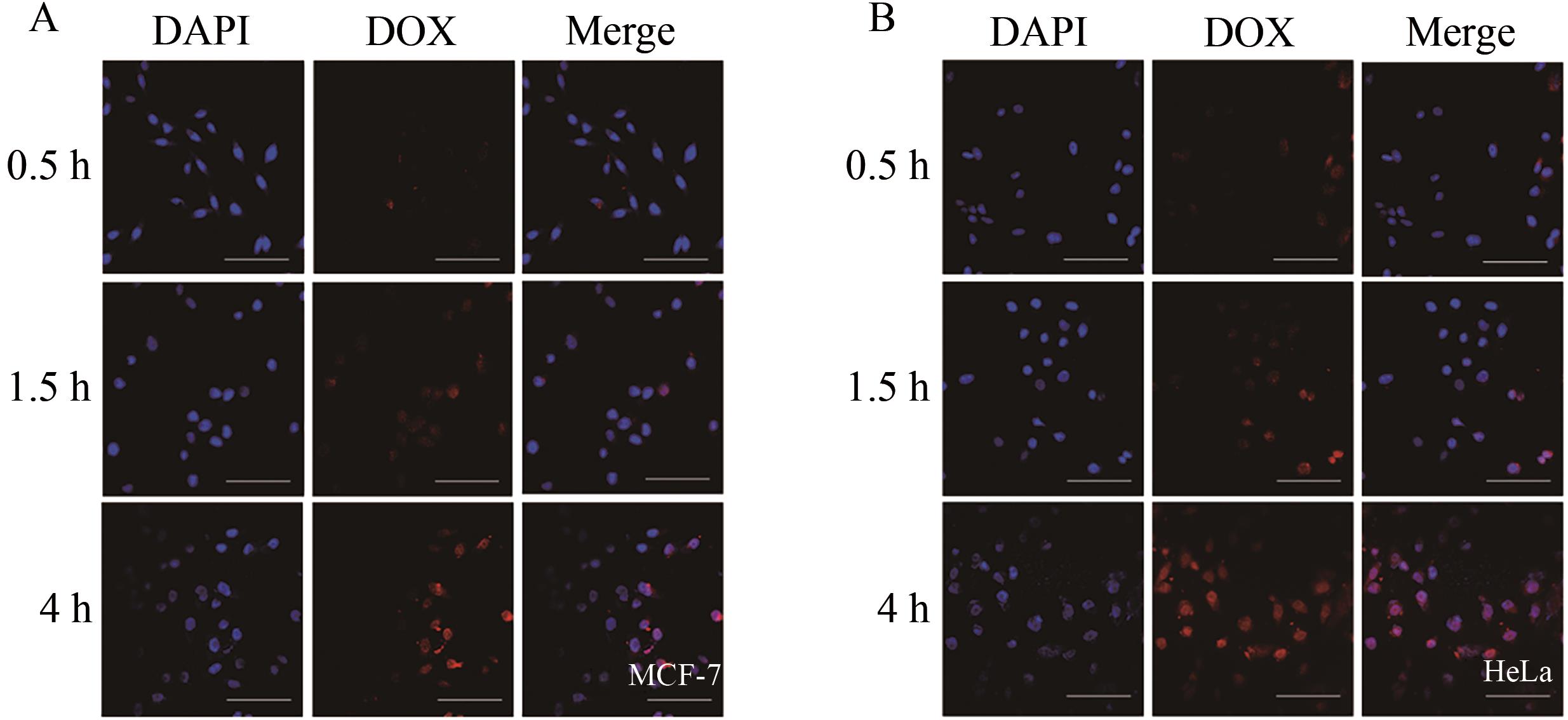
图9 GO-AuNP@DOX与MCF-7细胞(A)和HeLa细胞(B)分别共培养0.5、1.5和4 h后细胞荧光图
Fig.9 Cell fluorescence diagrams of GO-AuNP@DOX after respectively co-culture with MCF-7 cells (A) and HeLa cells (B) for 0.5, 1.5 and 4 h

图11 (A) NIR(808 nm, 2.0 W/cm2)照射下0~5 min,PBS组和GO-AuNP@DOX组处理的荷瘤小鼠肿瘤部位的热成像图; (B)不同处理条件下,小鼠的肿瘤组织图
Fig.11 (a) Thermal imaging of tumor sites treated with PBS and GO-AuNP@DOX under NIR irradiation (808 nm, 2.0 W/cm2) for 0~5 min; (B) Tumor tissue images of mice under different treatment conditions
| 1 | DOLATKHAH M, HASHEMZADEH N, BARAR J, et al. Stimuli-responsive graphene oxide and methotrexate-loaded magnetic nanoparticles for breast cancer-targeted therapy[J]. Nanomedicine, 2021, 16(24): 2155-2174. |
| 2 | HAN H S, CHOI K Y. Advances in nanomaterial-mediated photothermal cancer therapies: toward clinical applications[J]. Biomedicines, 2021, 9(3): 305. |
| 3 | CHEN J Q, NING C Y, ZHOU Z N, et al. Nanomaterials as photothermal therapeutic agents[J]. Prog Mater Sci, 2019, 99: 1-26. |
| 4 | NGUYEN V D, MIN H K, KIM D H, et al. Macrophage-mediated delivery of multifunctional nanotherapeutics for synergistic chemo-photothermal therapy of solid tumors[J]. ACS Appl Mater Interfaces, 2020, 12: 10130-10141. |
| 5 | WEN C, CHENG R, GONG T, et al. Cyclodextrin-cholic acid-hyaluronic acid polymer coated Fe3O4-graphene oxide nanohybrids as local chemo-photothermal synergistic agents for enhanced liver tumor therapy[J]. Colloids Surf B-Biointerfaces, 2020, 199: 111510. |
| 6 | WANG X, MA Q, WEN C, et al. Folic acid and deoxycholic acid derivative modified Fe3O4 nanoparticles for efficient pH-dependent drug release and multi-targeting against liver cancer cells[J]. RSC Adv, 2021, 11: 39804-39812. |
| 7 | GONG T, WANG X, MA Q, et al. Triformyl cholic acid and folic acid functionalized magnetic graphene oxide nanocomposites: multiple-targeted dual-modal synergistic chemotherapy/photothermal therapy for liver cancer[J]. J Inorg Biochem, 2021, 223: 111558. |
| 8 | BEIK J, ALAMZADEH Z, MIRRAHIMI M, et al. Multifunctional theranostic graphene oxide nanoflakes as MR imaging agents with enhanced photothermal and radiosensitizing properties[J]. ACS Appl Bio Mater, 2021, 4(5): 4280-4291. |
| 9 | YANG L, KIM T H, CHO H Y, et al. Hybrid graphene-gold nanoparticle-based nucleic acid conjugates for cancer-specific multimodal imaging and combined therapeutics[J]. Adv Funct Mater, 2021, 31(5): 2006918. |
| 10 | 张雅静, 王晓辉, 徐亚娟, 等. 石墨烯纳米载药体系的制备及对肿瘤细胞的杀伤作用[J]. 应用化学, 2021, 38(6): 693-703. |
| ZHANG Y J, WANG X H, XU Y J, et al. Preparation of graphene nano-drug carrier system and its killing effect on tumor cells[J]. Chin J Appl Chem, 2021, 38(6): 693-703. | |
| 11 | 张雅静, 季鹏, 韩德明, 等. 石墨烯纳米载药体系的制备及对人口腔鳞癌细胞杀伤效果[J]. 应用化学, 2019, 36(5): 564-570. |
| ZHANG Y J, JI P, HAN D M, et al. Preparation of graphene nano drug-loading system and its killing effect on human oral squamous cell carcinoma cells[J]. Chin J Appl Chem, 2019, 36(5): 564-570. | |
| 12 | CHENG S J, CHIU H Y, KUMAR P V, et al. Simultaneous drug delivery and cellular imaging using graphene oxide[J]. Biomater Sci, 2018, 6(4): 813-819. |
| 13 | BLOISE N, STRADA S, DACARRO G, et al. Gold nanoparticles contact with cancer cell: a brief update[J]. Int J Mol Sci, 2022, 23(14): 7683. |
| 14 | 李铸衡, 马立娜, 刘殿骏, 等. 金纳米粒子的细胞毒性[J]. 应用化学, 2016, 33(9): 1009-1016. |
| LI Z H, MA L N, LIU D J, et al. Cytotoxicity of gold nanoparticles[J]. Chin J Appl Chem, 2016, 33(9): 1009-1016. | |
| 15 | HU W G, YAN Z Y, LI H M, et al. Development of a new colloidal gold immunochromatographic strip for rapid detecting subgroup a of avian leukosis virus using colloidal gold nanoparticles[J]. Biochem Eng J, 2019, 148(15): 16-23. |
| 16 | AL RUGAIE O, JABIR M, KADHIM R, et al. Gold nanoparticles and graphene oxide flakes synergistic partaking in cytosolic bactericidal augmentation: role of ROS and NOX2 activity[J]. Microorganisms, 2021, 9(1): 101. |
| 17 | GONG T, WANG X, ZHU H, et al. Folic acid-maltodextrin polymer coated magnetic graphene oxide as a NIR-responsive nano-drug delivery system for chemo-photothermal synergistic inhibition of tumor cells[J]. RSC Adv, 2023, 13(18): 12609-12617. |
| 18 | WANG C, HUANG L, SONG S, et al. Targeted delivery and pH-responsive release of stereoisomeric anti-cancer drugs using β-cyclodextrin assemblied Fe3O4 nanoparticles[J]. Appl Surf Sci, 2015, 357: 2077-2086. |
| [1] | 张越, 梁蕊, 赵灿男, 李春梅. 氧化石墨烯-DNA纳米探针用于三磷酸腺苷的检测与药物递送[J]. 应用化学, 2024, 41(1): 118-127. |
| [2] | 郝威娜, 周超, 狄海萍, 邓林红. 基于氧化石墨烯-透明质酸-聚乙二醇的复合超分子水凝胶的制备及性能[J]. 应用化学, 2023, 40(12): 1672-1681. |
| [3] | 夏昉, 许子英, 王赫, 赫玉芳. 基于文献计量的氧化石墨烯特征分析[J]. 应用化学, 2023, 40(10): 1448-1455. |
| [4] | 赵跃华, 王大鹏. 氨基化氧化石墨烯和脂肪酸在水-油界面的共吸附动力学[J]. 应用化学, 2022, 39(8): 1274-1284. |
| [5] | 邵姗, 张剑, 邓凯强, 杨杰, 杨绍明. 镍钴双金属-卟啉有机框架复合纳米材料构建的无酶传感器检测多巴胺[J]. 应用化学, 2022, 39(7): 1098-1107. |
| [6] | 牛青芳, 艾欣, 王奕璇, 贺方玖, 罗彼, 梁文婷, 董川. 三维还原氧化石墨烯/β-环糊精复合物的合成及其电化学检测水中左氧氟沙星[J]. 应用化学, 2022, 39(7): 1129-1137. |
| [7] | 徐一鑫, 王爽, 全静, 高婉婷, 宋天群, 杨梅. 二硫化钼量子点/还原氧化石墨烯复合材料的制备及其光催化降解有机染料、四环素和Cr(VI)[J]. 应用化学, 2022, 39(5): 769-778. |
| [8] | 刘文彬, 杨莎莎, 黄国林, 樊利娇, 谢宇铭. 磷酸化黄原胶/氧化石墨烯的合成及其对铀的选择性吸附[J]. 应用化学, 2021, 38(6): 658-667. |
| [9] | 张雅静, 王晓辉, 徐亚娟, 刘文书, 赵丽辉. 石墨烯纳米载药体系的制备及对肿瘤细胞的杀伤作用[J]. 应用化学, 2021, 38(6): 693-703. |
| [10] | 肖海梅, 蔡蕾, 张朝晖, 陈珊, 周姝, 符金利. 磁性氧化石墨烯/MIL-101(Cr)表面金属离子印迹聚合物制备及其对Cu(Ⅱ)和Pb(Ⅱ)选择性吸附[J]. 应用化学, 2020, 37(9): 1076-1086. |
| [11] | 郜思衡, 杨宇, 毋金玲, 秦利霞, 康诗钊, 李向清. 氧化石墨烯/超细银粒子复合物的制备及其光电性能[J]. 应用化学, 2020, 37(8): 923-929. |
| [12] | 王伟, 李娟, 白茹, 韩珍, 冯雪薇, 孙越. 无金属可见光诱导原子转移自由基聚合法制备聚丙烯酰胺@氧化石墨烯/纳米钯复合物修饰电极及其对乙醇的检测[J]. 应用化学, 2020, 37(5): 595-603. |
| [13] | 霍朝晖, 杨晓珊, 陈晓丽, 张刚, 尹伟, 曹曼丽, 史蕾, 邱燕璇. 纳米银/二维石墨相氮化碳/还原氧化石墨烯复合材料的制备及其光催化降解抗生素[J]. 应用化学, 2020, 37(4): 471-480. |
| [14] | 于志强, 曲江英, 李杰兰, 臧云浩, 顾建峰, 高峰. 氧化石墨烯基柔性发电机的构筑及其水蒸发发电性能[J]. 应用化学, 2020, 37(10): 1164-1171. |
| [15] | 于志强, 曲江英, 李杰兰, 臧云浩, 顾建峰, 高峰. 氧化石墨烯基柔性发电机的构筑及其水蒸发发电性能[J]. 应用化学, 2020, 37(10): 0-0. |
| 阅读次数 | ||||||
|
全文 |
|
|||||
|
摘要 |
|
|||||

